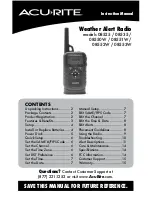
La Crosse Technology, Ltd.
Page 12
Use four screws to mount the wind sensor vertically on a piece of wood about 3 inches wide.
Be sure the metal mast holder faces north so the direction will read correctly.
Roof Mounting:
In most cases, at least 6 feet above the peak of the roof (or more) is required for
accurate readings (Avoid tall trees or other obstructions that may block or reflect the wind).
Ground Mounting:
Place at least 6 feet up on a pole in an open area̶higher is better. The wind
sensor should be the highest item in the immediate area. Mount the wind sensor away from all
obstacles that will block wind activity, such as trees and houses.
Mounting/Positioning rain transmitter
Make sure that the rain sensor is level. Inside there is a built-in level to assist in mounting. Make sure
the bubble is centered in the level.
Place the protective screen over the top to protect the rain sensor from the debris.
Where practical, mount the rain sensor in place with wood screws (not included).
Make sure that the rain sensor is in open area where precipitation falls directly into the sensor’s
bucket, ideally 3-6 feet above the ground.
Note:
The rain sensor will need debris removed on a regular basis. Mount in an accessible area.
Mount the rain sensor in an open area away from the walls, fences, trees and other coverings that
may reduce the amount of rain falling into the bucket. Additionally, trees and rooftops may be sources
of pollen and debris that may clog the rain sensor.
To avoid the rain shadow effects, place the rain sensor horizontally, at a distance about two to four
times the height of any nearby obstruction.
Be aware of other wireless rain gauges in the area that may cause interference.
The rain gauge is self-emptying and can be left out all year or stored in the winter. If stored for the
winter, remove the batteries to avoid leakage.
Position weather station
Make sure that the weather station is locating within the operating range of all remote sensors.
Mount the remote sensors within the line of sight of the weather station.
Trees, metal structures and electronic appliances may affect transmission range.
Test reception before permanently mounting all the remote sensors.
Mount near an exterior wall with the front or back facing toward Ft. Collins, Colorado for best WWVB
reception.
Do not place weather station in direct sunlight or on surfaces emitting and radiating heat, such as
heating ducts or air conditioners.
Avoid interference from the wireless devices (such as cordless phones, radio headsets, baby listening
devices, etc.) and electronic appliances. Place the weather station six feet or more from these
devices.
Distance/Resistance/Interference
Distance
:
The maximum transmitting range in
open air
is over 100 feet (30 meters) between the remote
transmitters and the weather station.
Consider what is in the signal path between the weather station and the transmitters.
Consider the distance the weather station is from other electronics in the home.
Resistance
:
Obstacles such as walls, windows, stucco, concrete and large metal objects can reduce the range.
When considering the distance between the transmitter and the weather station (100 feet, 30 meters
open air), cut that distance in half for each wall, window, tree, bush or other obstruction in the signal
path.
Closer is better.
Do not mount the transmitter on a metal fence. This significantly reduces the effective range.
Interference:
Consider items in the signal path between the transmitter and the weather station.
Simple relocation of the transmitter or the weather station may correct an interference issue.





































